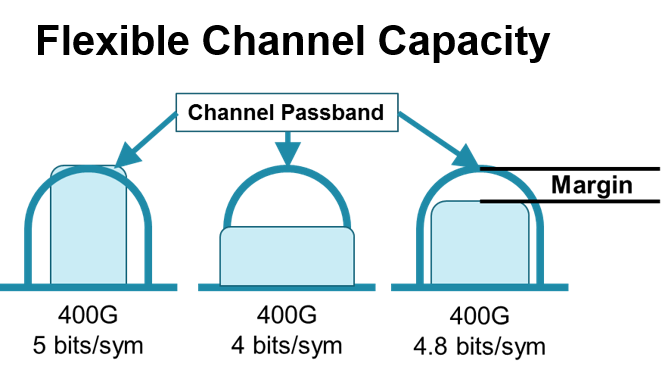Bandwidth demands continue to grow, driven by cloud, mobile, and IoT trends. These demands are fueling the need for key technologies, such as digital signal processing (DSP) and silicon photonics that evolve networks more efficiently. At ECOC, we unveiled our AC1200 Coherent Module, based on our Pico DSP ASIC. It utilizes two wavelengths, with up to 600 Gbps capacity each and supports transmission speeds of up to 1.2 Tbps in a footprint 40% smaller than 5” x 7” modules supporting 400 Gbps today.
In addition to its higher capacity and density, we are adding new features designed to enable network operators to improve efficiency while reducing network costs. Some of these new features being added include:
- Tunable Baud Rate – enables continuous baud rate adjustment for optimal utilization of the available spectrum
- Patented Fractional QAM Modulation – provides users with the ability to select very fine resolution of QAM constellations for optimal capacity
- Enhanced Turbo Product Code SD-FEC – offers ultra-high net coding gain (NCG) and enables maximum reach, while maintaining low power dissipation.
Let’s take a closer look at these new features to help you understand the benefits.
Optimize Utilization with Tunable Baud Rate
In general, optimal transmission performance is achieved by operating at the highest baud rate that fits within a given channel passband. Channel passbands can vary between networks and even between links in the same network. In most implementations, the baud rate of the coherent interconnect is either fixed or can be selected between a small number of settings. Acacia’s AC1200 coherent module is planned to allow flexible control of the baud rate over a wide range, giving network operators the ability to reduce regeneration stages and increase network margin.

Figure 1: Lower order modulation can more than double reach, reducing the need for expensive regeneration.
Optimize Capacity with Patented Fractional QAM Modulation
Acacia’s AC1200 is planned to support modulation formats where each symbol represents from 2 to 6 bits. Using just these integer steps allows network operators to select between several baud rates for a given channel capacity. Acacia’s Fractional QAM Modulation takes this one-step further, though, supporting many small increments between the integer steps. With this feature, the link margin can be optimized with much greater resolution than traditional interconnect technology.

Figure 2: Fractional QAM modulation can maximize channel capacity and link margin.
Maximize Reach with Low Power Leveraging Enhanced Turbo Product Code SD-FEC
Soft-decision Forward Error Correction (SD-FEC) has been widely used for coherent applications for several years now. Acacia has developed several SD-FEC implementations, based on Turbo Product Code (TPC) algorithms, achieving an exceptional combination of high performance and low power. With the AC1200 coherent module, Acacia is introducing a new Enhanced TPC code that is even more efficient. This high performance SD-FEC technology can reduce capex for network operators by further extending the reach of high capacity optical interconnects.
Acacia’s versatile AC1200 is planned to support multiple network applications, including DCI, metro, long-haul and submarine. With samples planned to be available in the first half of 2018, the AC1200 is well positioned to help network operators and content providers meet their growing bandwidth demands.
For more information on the AC1200, contact us at marketing@acacia-inc.com.
